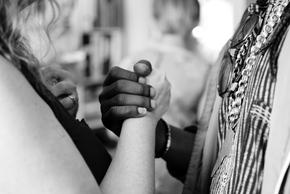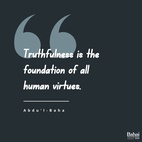The views expressed in our content reflect individual perspectives and do not represent the official views of the Baha'i Faith.
I am not “white” until you see me in swim trunks, and then yes, you can call me white.
But with clothes on and my olive semi-Italian-heritage skin, you’d have to call me “olive-complected,” or maybe even brown. Tell me truly, are you so dark I can call you “black?” Yes, some folks are, and also brown and tan and albino and just about every tone in between. But these are not “races,” as so many people think of them. Instead, they are at best only classifications by skin color and not by personality, background, skills, education, talents or abilities.
This division by color, calling ourselves the white race, black race, red race and yellow race must stop. Obviously, science has now proven we are one race and not four:
Despite notions to the contrary, there is only one human race. Our single race is independent of geographic origin, ethnicity, culture, color of skin or shape of eyes — we all share a single phenotype, the same or similar observable anatomical features and behavior.
Science highlights these similarities in our embryonic development, physiology (our organ-based systems), biochemistry (our metabolites and reactions), and more recently, genomics (our genetic makeup). As a molecular biologist, this last one is indeed the most important to me — data show that the DNA of any two human beings is 99.9 percent identical, and we all share the same set of genes, scientifically validating the existence of a single biological human race and one origin for all human beings. In short, we are all brothers and sisters.
Genetically speaking, studies have shown that there is much greater genetic variation within a given human population (e.g., Africans, Caucasians, or Asians) than between populations (Africans vs. Caucasions), indicating that human variation cannot be subdivided into discrete races. – Michael Hadjiargyrou, chair of the Department of Life Sciences at the New York Institute of Technology, Live Science, August 29, 2014.
So with that in mind, let’s look at the history of racial classifications, and see if we can learn how they came about.

Carl Linnaeus
The 1735 classification scheme dreamed up by the early biologist Carl Linnaeus, inventor of zoological taxonomy, divided the human species Homo sapiens into four continental varieties: europaeus, asiaticus, americanus, and afer; or in more contemporary terms; European, Asian, American and African.
Linnaeus also associated each of his four “races” with a different “humour:” sanguine, melancholic, choleric and phlegmatic. He called europaeus—the “white” race—“active, acute, and adventurous.” He called afer—the “black race”—“crafty, lazy and careless.”
So—does anyone think it’s a good idea to continue using Mr. Linnaeus’ classification scheme? Unfortunately, even though science now sees Linnaeus’ ideas about race as a ridiculous, many people still think the way he did. Of course, we now know his classifications, both by skin color and character, were wildly unscientific and prejudicial.
Forty years after Linnaeus first proposed his treatise, another scientist named Johann Friedrich Blumenbach wrote his own paper on racial classifications, The Natural Varieties of Mankind. In it, he proposed five major racial divisions: the Caucasoid race, the Mongoloid race, the Ethiopian race (later termed Negroid), the American Indian race, and the Malayan race.
Blumenbach, at least, did not propose any value-laden or judgmental character-related hierarchy among the races. He also observed a graded transition in appearance from one group to other groups, and suggested that “one variety of mankind does so sensibly pass into the other, that you cannot mark out the limits between them.” Most scientific observers, however, paid little attention to Blumenbach, and continued to accept the Linnaeus classification scheme.
All of these attempts at classifying people by skin color eventually produced an ideology of race. That ideology, which has stuck around for several centuries now, insists that racial divisions are natural, distinct and enduring; and that skin color has some kind of direct relationship to character. In America, that ideology is particularly pronounced, not only because of the U.S. history of slavery but also because of the racial theories of Thomas Jefferson, which had a significant and lasting influence on public opinion. Jefferson suspected that Africans were naturally inferior to whites, especially in regards to their intellect:
I advance it therefore as a suspicion only, that the blacks, whether originally a distinct race, or made distinct by time and circumstances, are inferior to the whites in the endowments both of body and mind. – Thomas Jefferson
As you can see, Linnaeus and Jefferson, and many others, set the tone for the initial mistaken concept of racial separation into skin color-determined categories. Predictably, that categorization scheme, conceptualized by Europeans, declared Europeans superior. It set public opinion in stone for the centuries that would follow, and has lasted up until modern times. Now, of course, these racial and skin color-related myths have been very eruditely and clearly exposed for the fallacious and specious thinking they contain. No credible scientist accepts them today; because the science of genetics has proven, without any doubt, that all racial and skin color-based divisions of humanity are completely artificial. They have absolutely no basis in fact. We are one, not four or five.
The Baha’i teachings promote the unification of one humanity, ask us to discard the “fancies and imaginations” of race, and encourage the elimination of every category that separates us as people:
Strive with heart and soul in order to bring about union and harmony among the white and the black and prove thereby the unity of the Baha’i world wherein distinction of colour findeth no place, but where hearts only are considered. Praise be to God, the hearts of the friends are united and linked together, whether they be from the east or the west, from north or from south, whether they be German, French, Japanese, American, and whether they pertain to the white, the black, the red, the yellow or the brown race. Variations of colour, of land and of race are of no importance in the Baha’i Faith; on the contrary, Baha’i unity overcometh them all and doeth away with all these fancies and imaginations. – Abdu’l-Baha, Selections from the Writings of Abdu’l-Baha, pp. 112-113.
The world desperately needs good examples of unity and harmony, of loving and learning and living together.
Millions of Baha’is around the globe work hard to institute these qualities in their lives and the lives of their communities, and to practice unity in their work, play, families, meetings, and interactions with all peoples of all hues and shades.
Someday, sooner I hope rather than later, it shall become reality.

















Comments
Sign in or create an account
Continue with Facebookor